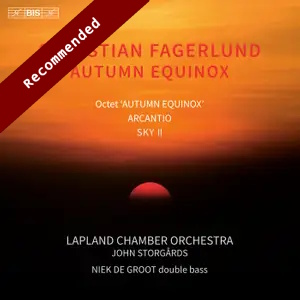
Sebastian Fagerlund (b. 1972)
Octet “Autumn Equinox” (2016)
Arcantio – Concerto for Double Bass and Chamber Orchestra (2023)
Sky II (2008, rev. 2023)
Niek de Groot (double bass)
Lapland Chamber Orchestra/John Storgårds
rec. 2023, Korundi House of Culture, Rovaniemi, Finland
BIS BIS-2090 SACD [53]
One of the most substantial recent works by Sebastian Fagerlund is his opera Höstsonaten (“Autumn Sonata”) completed in 2017. It has been recorded by BIS (BIS-2357) and my colleague Göran Forsling’s thorough and well-informed review is still available here. The octet Autumn Equinox does somewhat relate to the opera more by way of allusion than literal quotation. The piece was commissioned by the Delft Chamber Music Festival for a concert in August 2017. The other work in the concert was Schubert’s Octet. So, Fagerlund’s Octet is for the same instrumental combination i.e. clarinet, bassoon, horn and string quintet. The music shares some of its moods with the opera although there is just a short quote from the opera in the course of the piece. The octet is laid-out into three movements (roughly in the fast-slow-fast pattern). After a slow introduction presenting the octet’s material, the music of the first movement unfolds into a fast pulse throughout, almost in a minimalist mode. The second movement opens in a somewhat mysterious mood “from which melodic lines and different instrument’s arabesques begin to emerge”. In the middle of the movement is a section called Autumn Lullaby, actually the only direct quote from Höstsonaten, “that is dark-hued but harmonically more serene than the rest of the movement”. The viola has a very beautiful moment on its own after which the mood of the opening is briefly recalled. The third movement resumes the ebullient mood of the first one. The music becomes momentarily tenser but the initial impetus is restored and the music moves to its final climax. Autumn Equinox is a splendid example of Fagerlund’s instrumental mastery for the composer succeeds in creating a hugely varied sound picture often suggesting larger instrumental forces.
Fagerlund has so far composed a number of concertos such as the wonderful Cello Concerto Nomade (2018) as well as concertos for flute (Terral -2021), clarinet (2006), guitar (Transit – 2013) and violin (Darkness in Light – 2012). A concerto for double bass and chamber orchestra Arcantio has been added to this already quite impressive series. It was commissioned by the Lapland Chamber Orchestra. It is thus scored for somewhat smaller orchestral forces (single woodwind, horn, piano and strings). Fagerlund has known the present soloist for years and the concerto is dedicated to Niek de Groot. According to the composer the title refers to two things : to the feeling of an archaic melody and also to the implication of ‘song’ in the phrase ‘cantio’. However, what comes clearly through here is that the concerto, though overtly composed for a virtuoso player, is not simply a piece of mere technical display. There is indeed much emphasis on the singing quality of the soloist and the somewhat lighter scoring never obscures the soloist’s line. The overall structure of the piece is that of a theme and variations. The theme is stated Lento, con anima by the soloist and is followed by four variations. The fifth variation is a cadenza in all but the name for the soloist. The next two variations may be regarded as the fast section of the concerto leading straight into the expansive song of the ninth variation. The final variation Lento, misterioso brings this very fine work to its magical conclusion when the music dissipates into thin air. There are not that many concertos for double bass (one thinks of course of Tubin’s somewhat better-known concerto) and Fagerlund’s is undoubtedly a magnificent and most welcome addition to that rather limited repertoire. Needless to say that Niek de Groot plays superbly throughout with understanding and immaculate technique.
In 2008 Fagerlund composed a work for a ten-piece baroque ensemble Sky. The following year the work was adapted for modern instruments. This reworking formed the basis of a revised score completed in 2023 as Sky II, which is what is recorded here. It is scored for a chamber orchestra consisting in flute, clarinet, guitar, harpsichord and string quintet. Adapting the piece for modern instruments changed the very sound of the work but also its expression. Nevertheless, the most evident change is that the two baroque-era traversos were replaced by a flute and a clarinet whereas the theorbo was substituted by a guitar and one of the three violins was omitted. The composer has nevertheless retained the harpsichord and at times guitar and harpsichord are given the opportunity to improvise, based on the composer’s choice of scales. On the whole, Sky II is a lively and “most minimalist” work. It is a brilliant display of ensemble writing that rarely relents throughout the ten-minute work, almost a Scherzo in all but the name. A short, slower section allows the guitar to take the lead for a while but it does not last long and there original impetus is quickly regained until the final climax (“a kind of modern folk music”) before the evanescent conclusion. One of my old friends would have described Sky II as a “jolly good piece of music” which it actually is. It provides this fine release with an uplifting close.
As might be expected, nothing here is found wanting. The playing and the recording are just superb, along BIS’ best standards and I must one gain mention Kimmo Korhonen’s excellent notes from which I have quoted. In short, a very fine release and another most welcome addition to Fagerlund’s discography.
Hubert Culot
Buying this recording via a link below generates revenue for MWI, which helps the site remain free




















